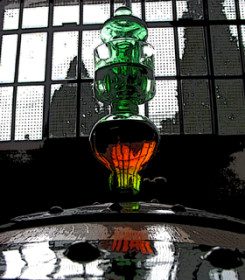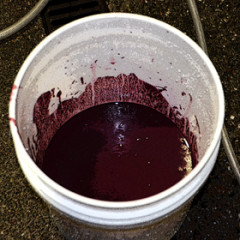Wild, Cultured or GM; Is Yeast a Fermenting Controversy?
Chapter Twelve. Part Five.
In an effort to tame the temperamental tribulations of fermentation, men have long tinkered with yeast, and as a result, winemakers now have many types of these little critters in their winemaking arsenal. Despite their differences, the one thing that all yeast organisms have figured out is how to convert sugar into alcohol, which is a far greater achievement than anything my college buddies have done with their lives.
Although wild yeast permeates the vineyards and wineries, many winemakers prefer to use cultured yeasts because they come from well-heeled families. Wild yeasts are uncultivated party animals and are therefore less predictable (of course unpredictable can also mean crazy-good). Think of it this way; uncultivated yeasts are like the wine bloggers of the fungi world but not quite as moldy.
Winemakers have learned that distinctive flavor and aroma compounds can be created from different strains of cultured yeast. While one species may produce the gooseberry aroma in a New Zealand Sauvignon Blanc, another may create the barnyard characteristics found in certain Burgundies. Scientists who don’t get out of the lab very often refer to the subtle flavor nuances imparted by different yeast strains as yeast inflections.
One development that’s certain to become controversial is the introduction of genetically modified (GM) yeast organisms. Your favorite wine might be produced from GM yeast but you can’t tell from the bottle, as US labeling laws do not require any mention of GM ingredients. This revelation hasn’t, as yet, provoked any outcries from the growing anti GM movement so for now it’s safe to say this is only a fermenting controversy (beer industry insiders refer to this as a brewing controversy).
GM yeast organisms could solve dozens of ancient problems while simultaneously altering the face of modern winemaking. Canada, South Africa and the United States have all given the green light to a Canadian GM yeast strain that conducts malolactic fermentation concurrently with alcoholic fermentation (traditionally a two-step process). This supposedly produces fewer allergenic chemicals that can create migraines and hypertension. This, they maintain, will create the first headache-free wine.
Sta. Rita Hills winemaker Bryan Babcock of Babcock Winery raised these points. “So the logic on this is that all non-malolactic wines in the past could not have produced any headaches. Hmmm … it’s a question of how the wines turn out … do the new strains impart anything awkward, do the strains impart any particular flavors vis a vis their malolactic capabilities? Many malo bacteria impart beneficial flavors especially in whites. Would that be missing with the new yeasts?”
If GM yeasts impart any undesirable characteristics, are the benefits worth the risk of contamination to the native yeast organisms that so many winemakers rely on? In an article in the Napa Valley Register, Erica Martenson wrote;
… this GM wine yeast could contaminate native and traditional wine yeasts through the air, surface waste and water runoff. Many wineries here in the Napa Valley are very particular about their choice of wine yeast, and contamination of these various yeast strains would truly be a shame.¹
Among other purported advantages, GM yeasts can be used to induce more efficient fermentation, softer mouth feel, enhanced aroma or flavor liberation, and higher alcohol tolerance. Before many of today’s super-yeasts were available, yeast organisms would die once the alcohol level in a vat of fermenting wine reached a certain level.
“There are already many “selected” yeast that can get to 16% or 17% alcohol easily (why anyone would want to do this I don’t know)” said Aaron Pott, whose winemaking resume includes stints at Château Troplong Mondot, Château La Tour Figeac, St. Clement, Quintessa, Chester’s Anvil, Bello Family, Blackbird, and of course, Pott Wines. “I don’t use any GM yeast. My philosophy is, why pay for something that you can get for free floating around in the air and that is better than anything you can buy!”
According to Martenson, the question of whether or not these free native yeasts remain “better” may depend on their reaction when GM yeasts are introduced into the environment. It remains to be seen whether cross breeding between GM yeast and native yeasts (or whatever it is that unchaperoned microorganisms do) forever alters the way wine is made and how it tastes.
Regardless of whether yeast is wild, cultured, uncultured or genetically modified, these lemmings of the fermentation vat gorge themselves on the grape sugars until they die. Once the yeast has converted all of the sugar into alcohol, the wine is considered dry and the dead yeast cells fall to the bottom of the fermentation vessel. These cells are referred to as lees and are often left in contact with the wine during aging to impart richness and flavor.
Some yeast or bacteria may survive the fermentation process and must be eliminated to prevent future problems. Fermentation can be arrested by dropping the temperature of the wine or by adding alcohol (typically brandy) until the mixture becomes toxic to yeast organisms. Fortified dessert wines are created when alcohol is added to the fermenting wine while the sugar levels are still high. The incapacitated yeast can no longer ferment the sugar, which results in a strong but sweet wine that is best enjoyed in a later chapter. Another way to debilitate yeast, as well as other bacteria, is by the addition of sulfur, which I will add in my next blog.
¹ “The Dangers of Genetically Modified Wine Yeast.” NapaValleyRegister.com Dec. 12, 2006 http://napavalleyregister.com/news/opinion/mailbag/the-dangers-of-genetically-modified-wine-yeast/article_39c3f9f4-2c48-5a75-ab18-aeb435c62756.html






















